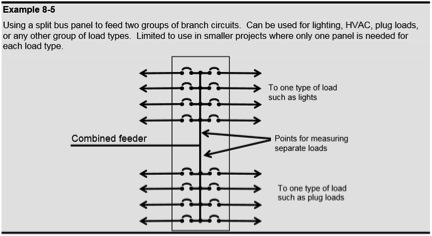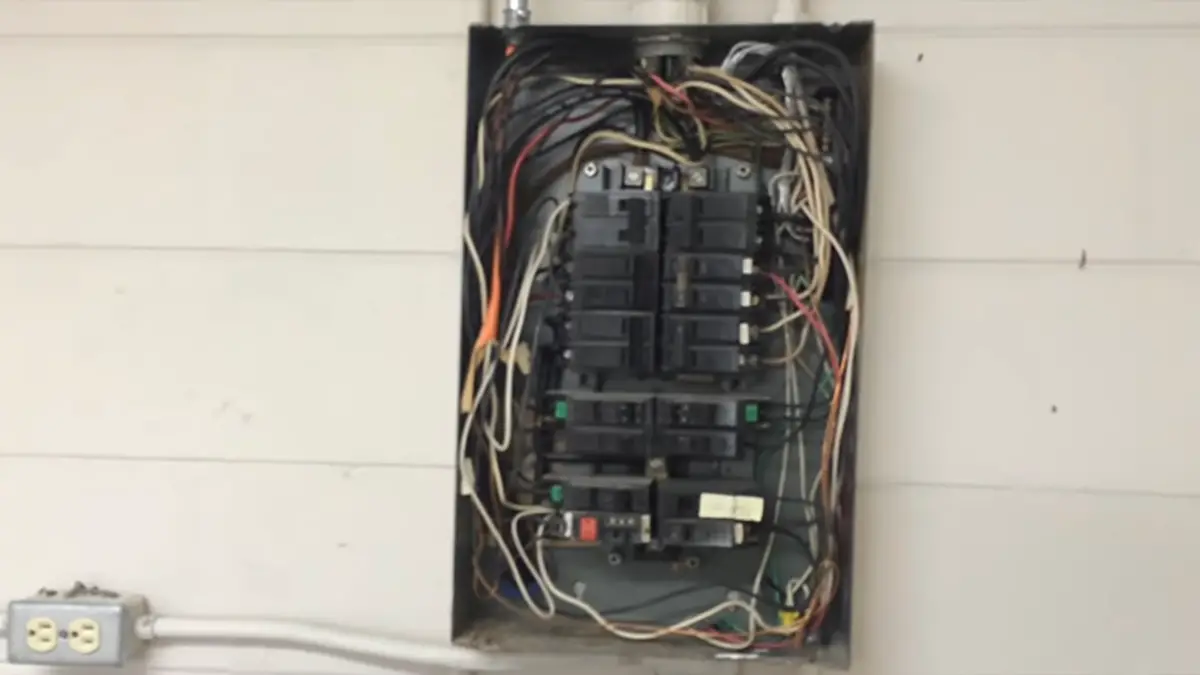A split bus panel is an electrical panel with two bus bars – the top one specifically dedicated to larger appliances. In contrast, the lower bar carries current and holds circuit breakers suitable for general lighting.
Today’s electrical panels have one bus bar supplying electricity from the main breaker. From there, it goes to the rest of the circuit breakers.
The main disconnect is helpful because we can easily cut all the power in the building by flipping one breaker in an emergency. However, some older panels had two bus bars with no main breaker (some of the older Murray panels, for example). These are known as split bus electric panels.
Split bus panels are not necessarily dangerous, but they are outdated. Failures are often a result of age-related malfunctions or overloading. Split bus electric panels do not meet current NEC safety codes leading to higher failure rates than modern electrical panels.
Split bus electrical panels haven’t been used for well over 40 years. As we stated, this makes them well beyond a panel’s expected lifespan. The NEC no longer allows multiple main disconnects.
Other problems related to split bus breaker panels are aluminum and ungrounded wiring, as they were commonly part of the electrical installs in that period. If you have one in your home, you should consult an electrician about possible panel replacement.
You can likely update the panel without a whole house rewire. The NEC allows a panel upgrade and replacement of 2-prong ungrounded outlets without rewiring provided the circuit is GFCI protected, although rewiring with grounded wiring is the best option.
Get FREE estimates from licensed electricians in your area today. Whether you need to replace an outlet, hang a ceiling fan, a new electrical panel, or repair wiring, We Can Help!
What is a Split Bus Panel?
A split bus electric panel is an electrical circuit breaker panel that divides the main power into two separate circuits: one for the main power to 240-volt large appliances and one for the 120-volt branch circuits. It is typically used in home wiring applications to provide more flexibility and safety when working with electrical wiring.
Split Bus Panel Diagram: How to Identify?
Identifying a split bus electrical panel with a diagram can help in electrical troubleshooting and installation.

How Does A Split Bus Electrical Panel Work?
The diagram and video clearly demonstrate that the split bus panel contains two separate buses. The upper one is often utilized for major appliances and accommodates up to 6 breakers. In contrast, one of those breakers supplies current to the lower part of the system, generally used for lighting fixtures or outlets in a house.
Split bus panels were a popular choice from the 1950s to the 1980s. However, as technology advanced and homes required more electricity, these panels quickly fell out of favor due to arising issues.
Electricians and handymen started overloading split bus boxes by adding single-pole breakers to their top bars, which caused extreme heat buildup, arcing, and significant damage. Thus leading them to be discontinued in the 1980s.
Today, these panels may need an upgrade to abide by the National Electrical Code “six throws” rule if the top bus exceeds six 2-pole breakers.
Moreover, these outdated circuit breakers and panels have exceeded 40 years of age and beyond their useful life and require inspection by a licensed electrician or replacement as specified by several insurance companies.
What is the Six Throw Rule?
According to the National Electrical Code, power must be able to be shut off with no more than six breakers or throws. However, if there are more throws than six in this type of paneling, it would not be up-to-code.
“Maximum number of Disconnects.
(A)General. The service disconnecting means for each service permitted by 230.2, or for each set of service-entrance conductors permitted by 230.40…shall consist of not more than six switches or sets of breakers, or a combination of not more than six switches and sets of breakers, mounted in a single enclosure, in a group of separate enclosures, or in a switchgear.”
A split bus circuit breaker panel only becomes defective when the main section exceeds six disconnects. Generally, an untrained individual such as a homeowner substitutes one of the double pole breakers with two single pole breakers; thus leading to seven instead of six disconnections – which is against the maximum allowance prescribed by 230.71.

Is a Split Bus Panel Dangerous?
Although having six main circuit breakers rather than just one might not seem like a significant difference, it is still considered as only one main disconnect.
Some home inspectors and electricians may believe these panels are outdated and should be upgraded to modern electrical ones.
However, this isn’t necessarily the case since the Consumer Product Safety Commission (CPSC) has reported that breakers can last up to 30-40 years before replacing. The CPSC has not recalled split bus panels; when installed as intended, they are safe.
While these panels are no longer manufactured or installed, they were legal when installed and do not require replacement unless significant electrical work is necessary, such as a major home remodeling project or malfunction.
Upgrading your panel is only required when additional circuits or higher amp service are needed and not simply because of safety hazards with split bus breaker boxes – a common home inspection misconception.
Although there may be certain brands, such as Federal Pacific Electric Panels and Zinsco Panels, that present fire risks, these dangers should not be generalized for all panels of this design.
Conclusion
Split bus panels are electrical systems with two bus bars, the upper one providing power to major home appliances while the lower bar supplies electricity to general lighting and outlets. One single circuit breaker from the top connects both bars so that you can access energy anywhere in your residence without any trouble.
According to the National Electrical Code, a split bus panel must be capable of cutting off home power with six throws (or breakers) due to not having its own main shut-off switch.
In today’s world, many of these panels have been haphazardly retrofitted to accommodate the current electrical requirements. This careless fixing has resulted in overloaded circuits, overheating and arcing, and damage to homes. As a result, these circuit breaker panels must be carefully inspected, repaired, or replaced for better performance.
As a home inspector, one of the most frequent misunderstandings is that all main panels must have a single main breaker. Contrary to this belief, the NEC only requires proper disconnecting means in place – not necessarily having to be composed of just one primary breaker. It meets NEC guidelines as long as the top bus does not exceed six two-pole breakers and is free of other defects.








